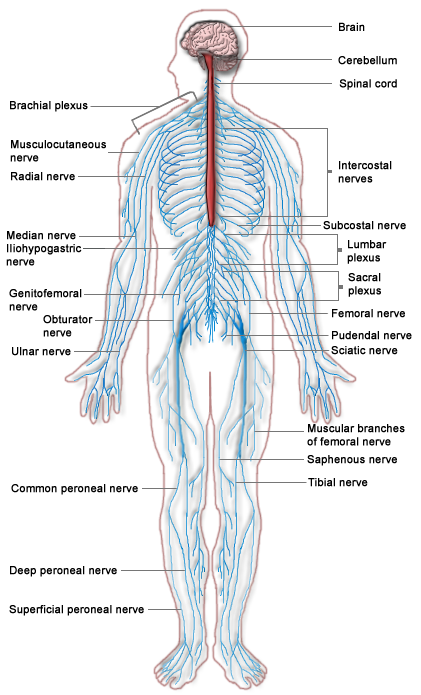The peripheral nervous system, or PNS, informs our brain of the world around us. It consists of nerves that run to and from the brain and spinal cord, carrying messages between the central nervous system and the body. These messages either carry sensations back to the brain or initiate muscular movement. We are aware of them and sometimes control them voluntarily.
The autonomic nervous system, or ANS, can be regarded as part of the PNS but controls our involuntary functions. We are usually unaware of the ANS and the messages it sends between the brain and our internal organs, muscles and glands.
The peripheral nervous system is made up of 12 pairs of cranial nerves that start at the base of the brain, and 31 pairs of spinal nerves that leave the spinal cord through spaces between the vertebrae.
Messages travelling to the brain are called sensory because they bring sensations such as touch, taste or sight, while those travelling from the brain are called motor, because they initiate movement. Some cranial nerves are mixed - they are two-way streets that allow both types of signal to pass. The cranial nerves mainly serve the head and neck. The only one that travels further afield into the body is the vegas nerve and this is an important part of the autonomic, not the peripheral, nervous system.

All 31 pairs of spinal nerves are mixed, carrying sensory messages to, and motor signals from the brain. The back of the spinal cord is dedicated to sensory impulses travelling upwards, while the front deals with motor impulses moving downwards.
A pair of spinal nerves consists of one nerve serving the right side of the body and one serving the left. They are usually called my a shorthand name made up of the initial of the region they originate from, and the order in which they run. Nerves leaving the neck, or cervical region of the spine are prefixed with C. As there are eight pairs of them they are named C1 to C8. they serve the neck shoulder, arms, hands and diaphragm. There are 12 pairs of thoracic nerves. These supply the intercostal muscles, some of the back an the abdomen. The five pairs of lumbar nerves supply the lower back and parts of the legs.
The five pairs of sacral nerves, which leave through openings in the sacrum, plus the four pairs of coccygeal nerves, serve the buttocks, genital region, legs and feet. Some of these nerves pass directly to their target areas, whereas some (rather like junction boxes) join with branches of other nerves, to serve areas of more complex function, such as the neck and shoulder. Having left the spinal cord, nerves subdivide again and again, becoming smaller and finer as they travel to the extremities of the body.
Safety Mechanism
It is our peripheral nervous system that enables us to perform reflex actions. The best example is what happens when your hand touches a very hot surface. The message of intense heat travels along sensory nerve fibres up your arm to your spinal cord and then up the back of the spinal cord to your brain. Once there, the surface you have touche would be interpreted as dangerously hot and a motor impulse would be sent down the front of the spinal cord and out along the relevant motor nerve fibres to move your arm away from the heat source. As nerve impulses travel at around 65 kilometers per hour, this process wouldn't take long. However, it could still be long enough for your hand to be burned. If the heat message is strong enough, when it reaches your spinal cord, some of it will jump from the sensory back section across to the motor front section, causing your arm to pull away from the heat in a reflex movement. Meanwhile, the sensory message will continue to the brain, resulting in you feeling the heat an pain only after you've removed your hand.
On Autopilot

The autonomic nervous system monitors our breathing, regulates our heartbeat and blood pressure, balances blood sugar and minerals, digests our food and makes urine. The autonomic system is divided into two - the sympathetic and the parasympathetic branches.
These work in balanced opposition throughout the day to ensure we respond as necessary to changing stimuli. If we have to run for the train, our sympathetic branch kicks in. When we relax with our favourite meditation tape, our parasympathetic branch takes over.
Fight or Flight
When we're faced with some form of stress, physical or emotional, the sympathetic branch prepares the body for a 'fight or flight' response by triggering the release of adrenaline. At the same time it stimulates the conversion of stored carbohydrates into glucose by the liver, increases sweating and muscle contraction, and inhibits digestion and kidney function so we can respond more effectively to the threat. Over time, overuse of the fight or flight response can result in an unbalanced state of health as the body become less able to cope with this constant stimulation.